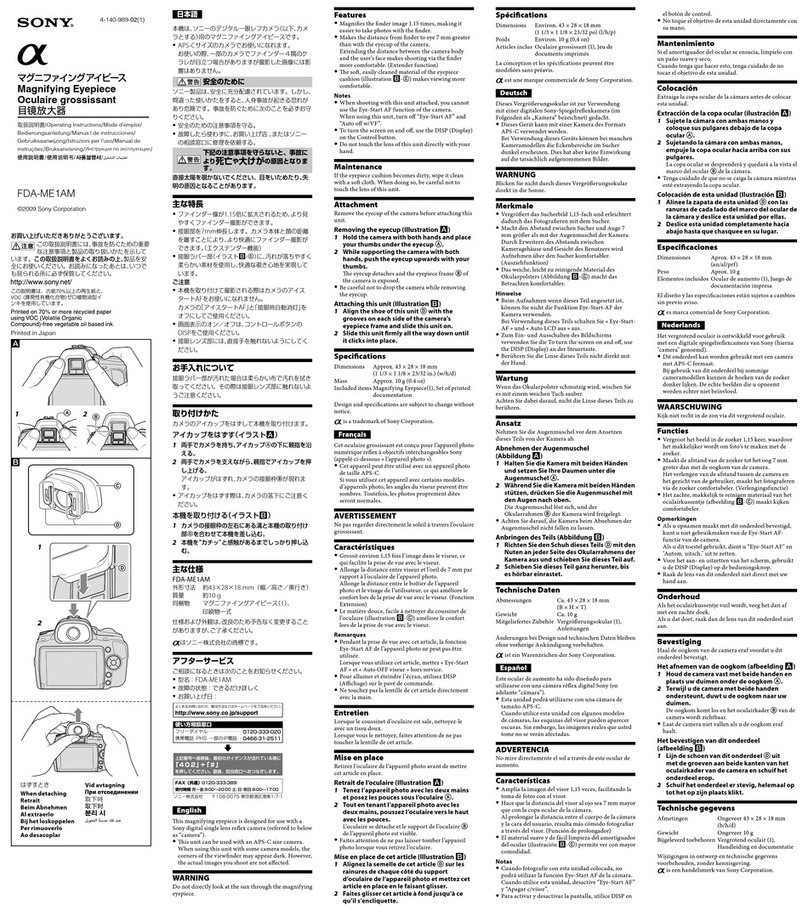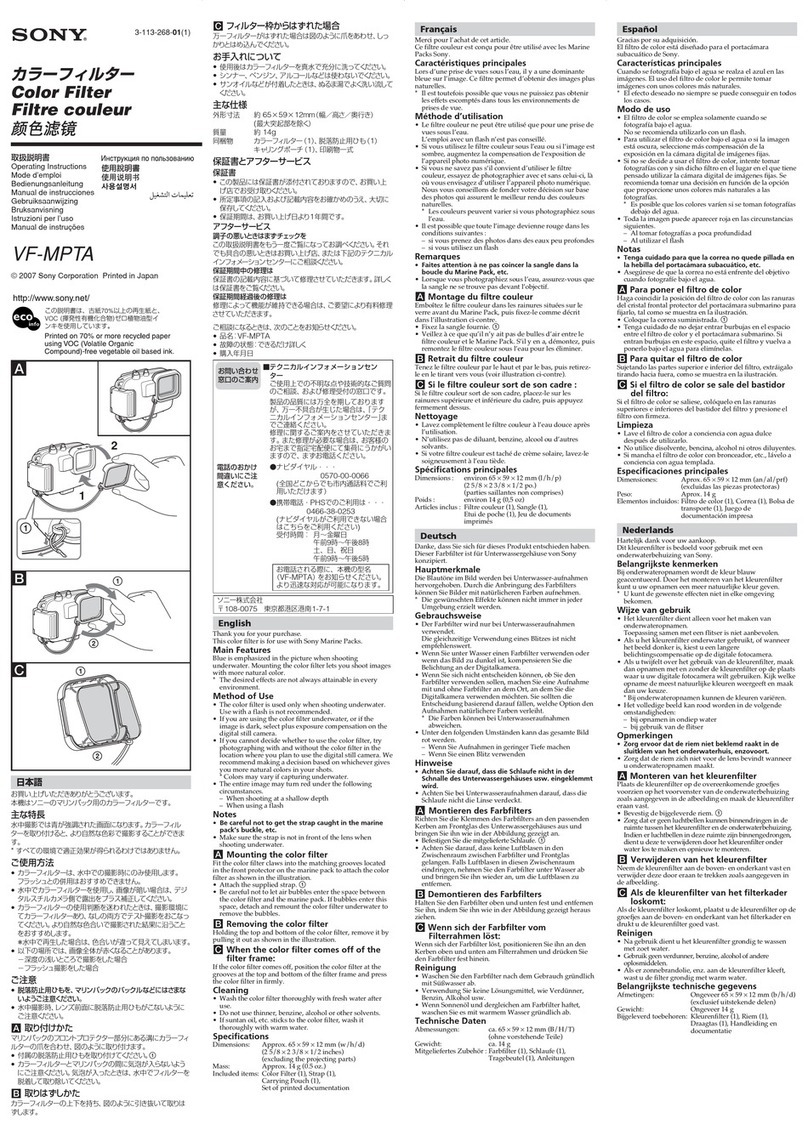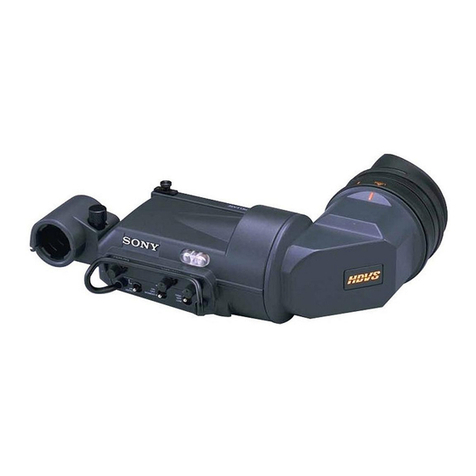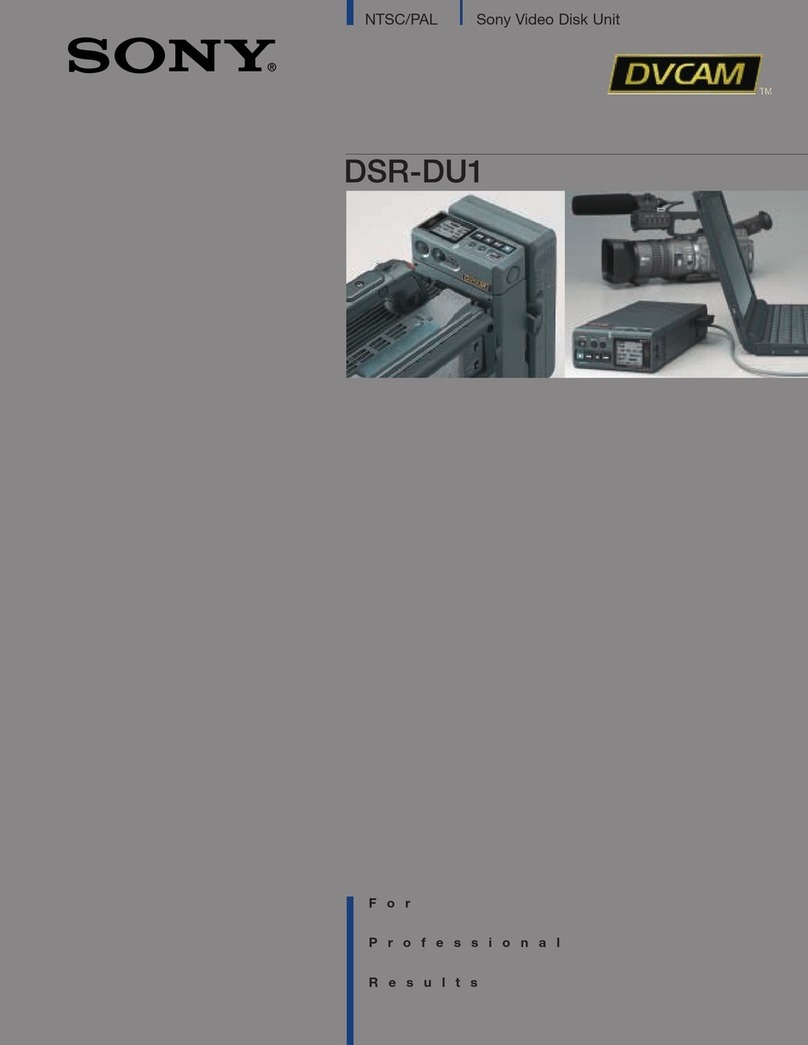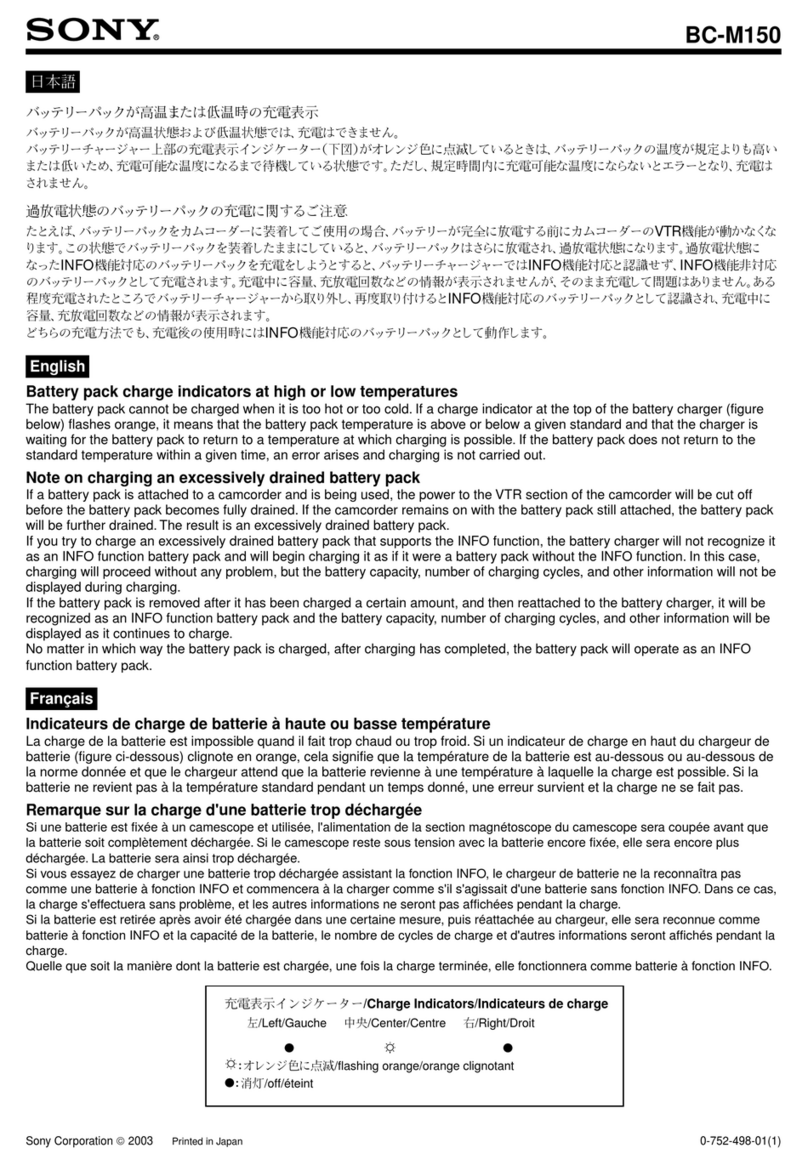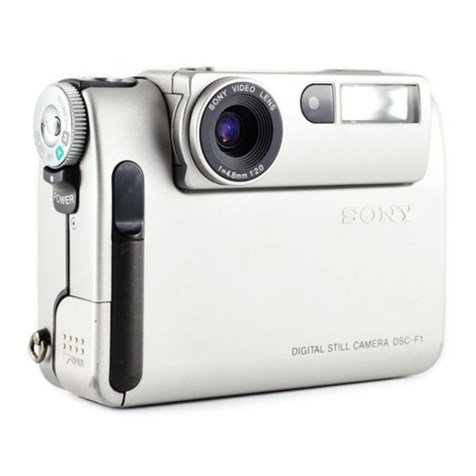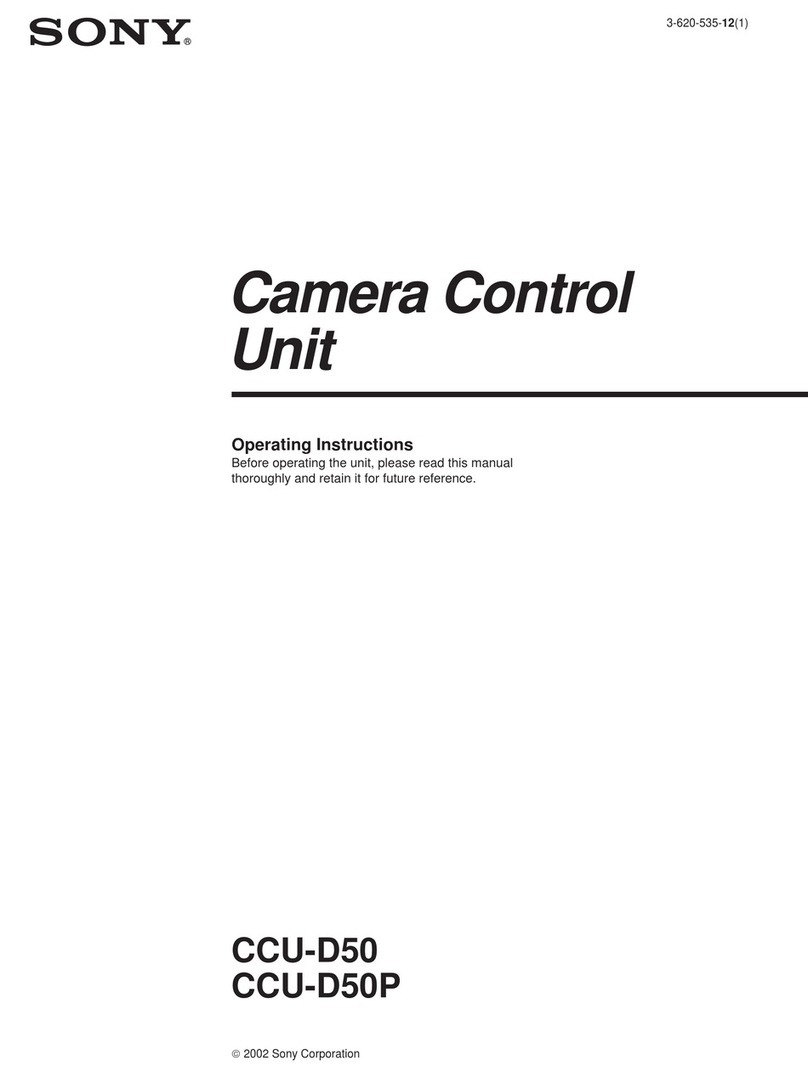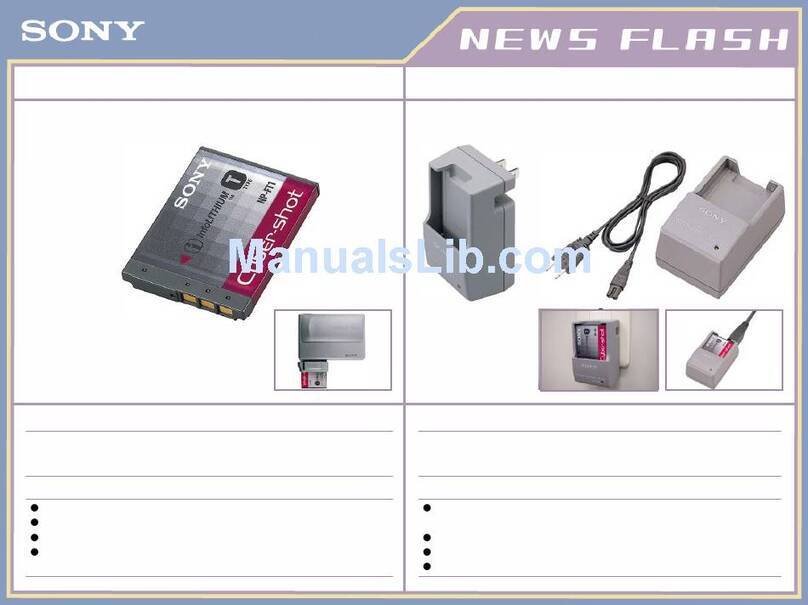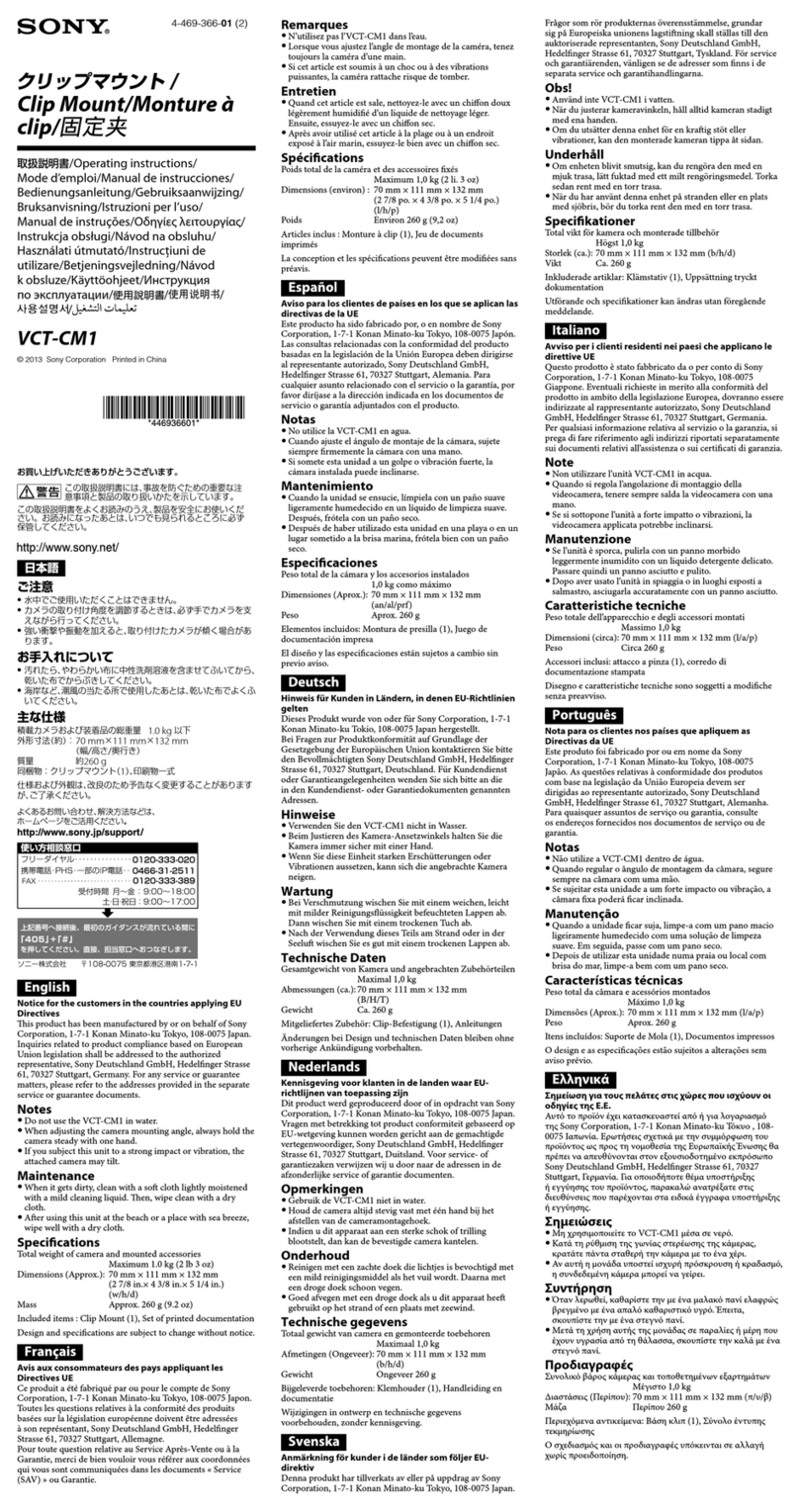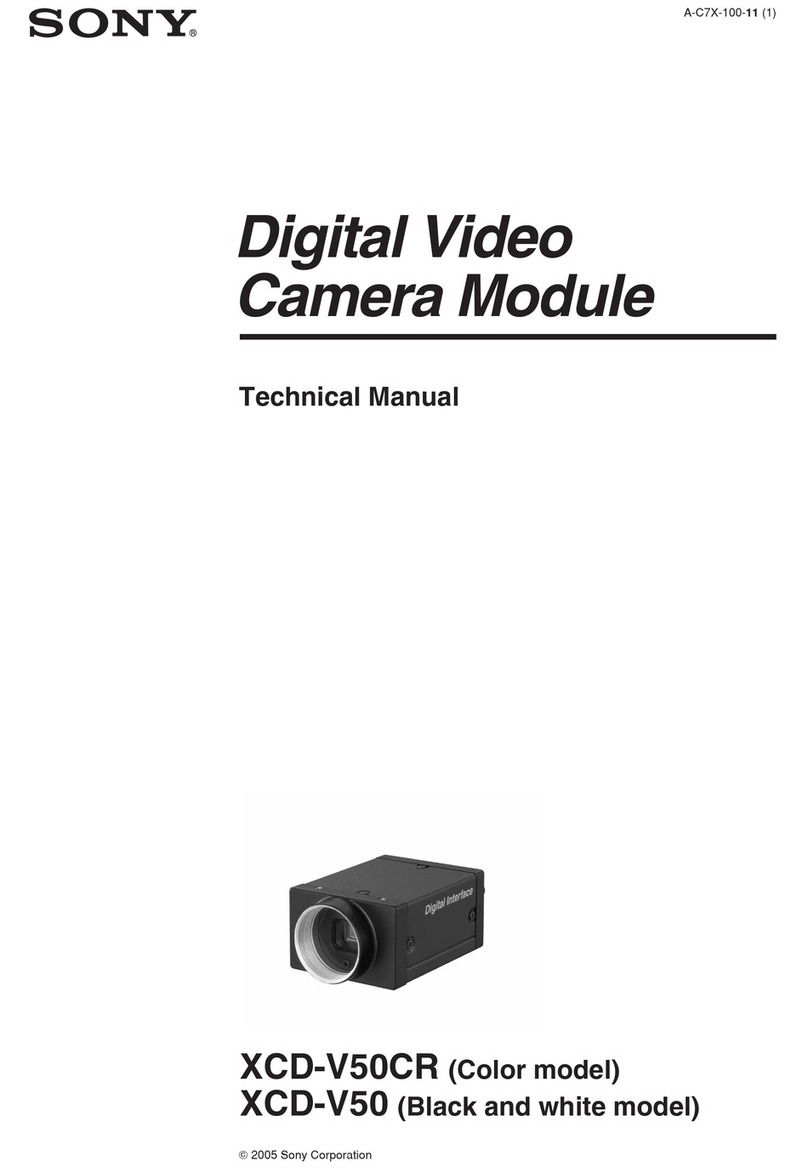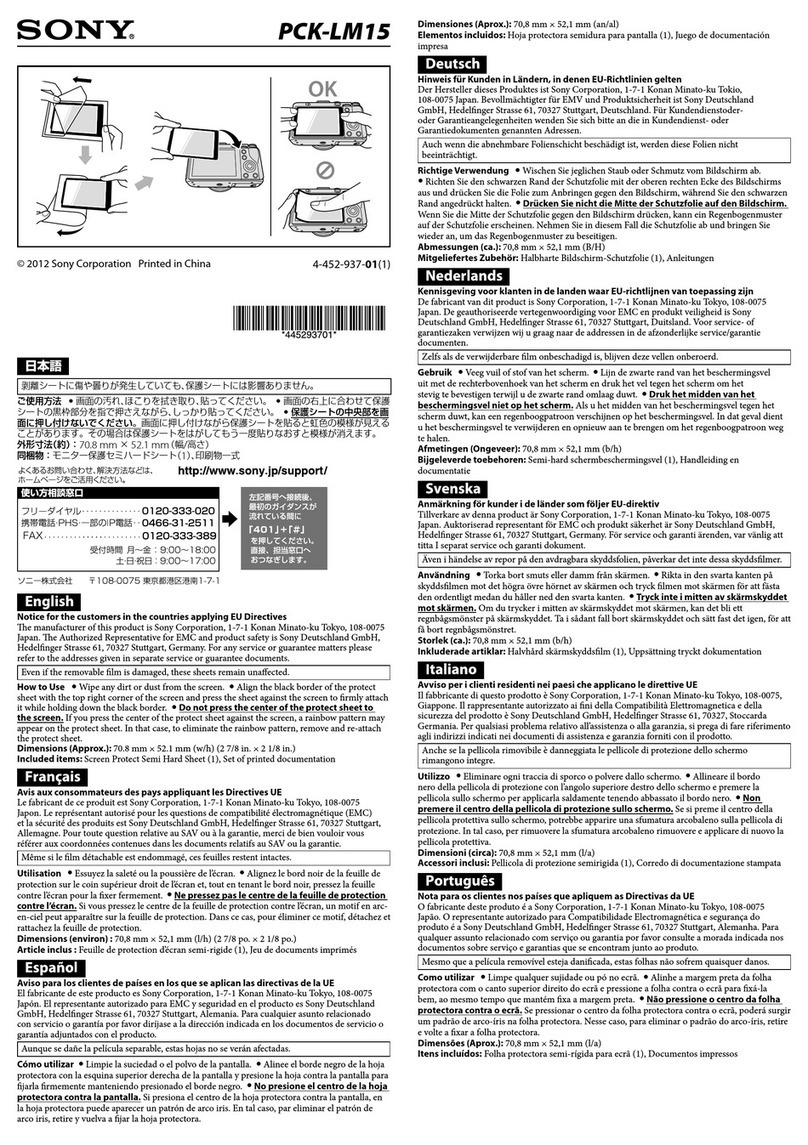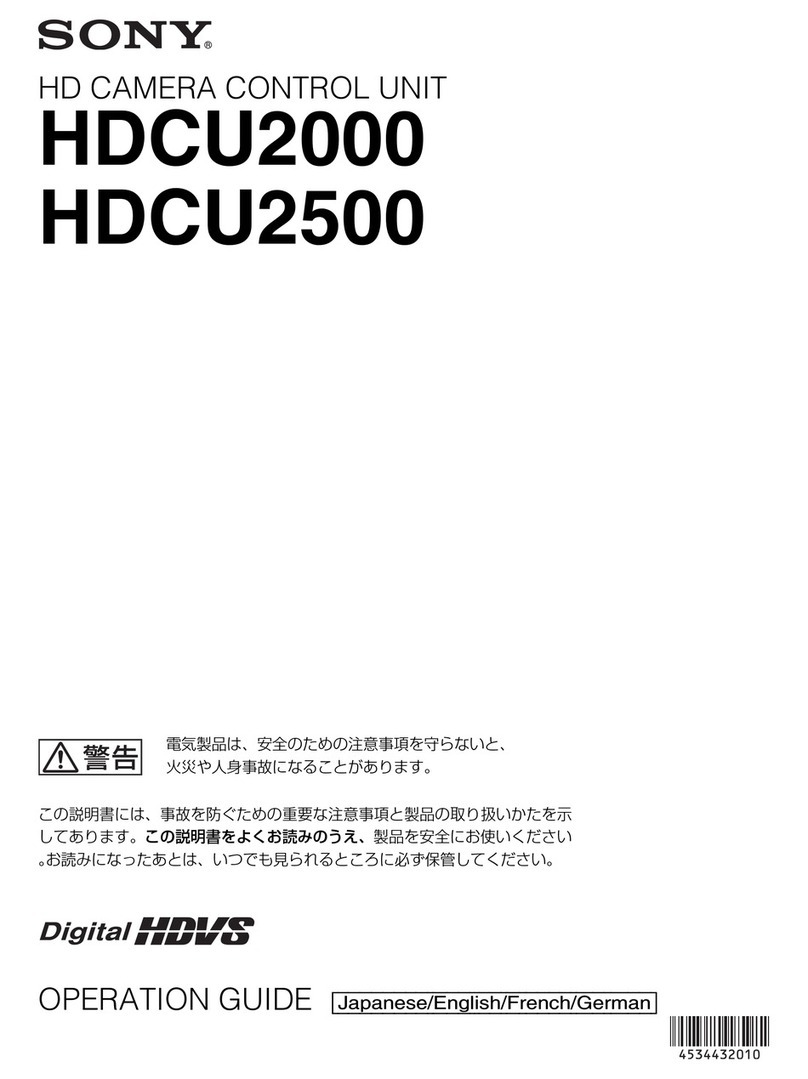
安全のために
ソニー製品は、安全に充分配慮されています。しかし、間違った使
いかたをすると、人身事故が起きる恐れがあり危険です。事故を
防ぐために次のことを必ずお守りください。
安全のための注意事項を守る。
ˎ
故障したら使わずに、お買い上げ店、またはソニーの相談窓口に
ˎ
修理を依頼する。
下記の注意事項を守らないと、
事故により死亡や大けがの
原因となります。
分解や改造をしない
火災や感電の原因となります。内部点検や修理はソニー
の相談窓口にご依頼ください。
乳幼児の手の届く場所に置かない
事故やけがなどの原因となります。
透過ミラーが破損した場合は触れない
けがなどの原因となります。
マウントアダプター LA-EA2
(以下、本機とする)は、Aマウント搭
載のαレンズ(以下、レンズとする)をEマウント搭載のソニー製
レンズ交換式デジタルカメラおよびレンズ交換式デジタルHDビ
デオカメラレコーダー(以下、カメラとする)に取り付けるための
アダプターです。
使用上のご注意
透過ミラーおよび本機の内部を触らないでください。やむを得
ˎ
ずゴミがついた場合は、ブロアをお使いください。
本機を装着するときやご使用になる際には、衝撃を与えないよ
ˎ
うにご注意ください。
レンズの交換は、ゴミやほこりの少ない場所で行ってください。
ˎ
レンズ信号接点を触らないでください。よごれ等により接触不
ˎ
良になると、カメラとの信号のやりとりが正しく行われず、カメ
ラが正しく動作しなくなりますのでご注意ください。
本機にレンズを装着する際には、下記の内容に注意してご使用
ˎ
ください。
三脚をお使いになる場合で下記レンズをお使いのときは、マウ
ント部分に負荷がかかるため、レンズ側に三脚などを取り付け
てください。
70-200mm F2.8G (SAL70200G)
70-400mm F4-5.6G SSM (SAL70400G)
300mm F2.8G (SAL300F28G)
本機に三脚を取り付けるときは、ネジの長さが5.5mm未満の三
ˎ
脚をお使いください。ネジの長さが5.5mm以上の三脚ではしっ
かり固定できず、傷を付けることがあります。
本機を持ち運ぶ際は、ボディキャップおよびレンズリヤキャッ
ˎ
プを装着し、キャリングケースに入れてください。
レンズを取り付けてカメラを持ち運ぶときは、カメラとレンズ
ˎ
の両方をしっかり持ってください。
保管について
必ず本機にボディキャップおよびレンズリヤキャップを取り付
ˎ
けてください。
湿度の高い場所に長期間置かないでください。カビが発生する
ˎ
ことがあります。
結露について
結露とは、寒い場所から急に暖かい場所へ持ち込んだときなど
ˎ
に、本機の内側や外側に水滴が付くことです。結露を起こりに
くくするためには、一度本機をポリ袋かバッグなどに入れて、使
用する環境の温度になじませてから、取り出してください。
お手入れについて
お手入れには、シンナー、ベンジンなどの有機溶剤は絶対に使わ
ˎ
ないでください。
各部の名前
1…透過ミラー
2…Eマウント標点
3…Eマウント
4…レンズ信号接点
5…Aマウント指標
6…レンズ取りはずしボタン
7…Aマウント
8…三脚用ネジ穴
取り付けかた/取りはずしかた
取り付けかた
取り付ける前に
カメラの電源スイッチを「OFF」にしてください。
ˎ
1本機のレンズリヤキャップ(Eマウント側)、カメ
ラに取り付けているレンズをそれぞれはずす。
本機のレンズリヤキャップは反時計方向に回すとはずれま
ˎ
す。
2本機の白の点(Eマウント標点)を、カメラの白の
点(マウント指標)に合わせてはめ込み、本機を軽
くカメラに押し当てながら、時計方向に「カチッ」
とロックがかかるまでゆっくり回す。
本機を取り付けるときに、カメラのレンズ取りはずしボタ
ˎ
ンを押さないでください。
本機を斜めに差し込まないようにしてください。
ˎ
3本機のボディキャップ(Aマウント側)、レンズの
レンズリヤキャップをそれぞれはずす。
本機のボディキャップは反時計方向に回すとはずれます。
ˎ
4レンズのオレンジの点(マウント標点)を、本機の
オレンジの点(Aマウント指標)に合わせてはめ込
み、レンズを軽く本機に押し当てながら、時計方向
に「カチッ」とロックがかかるまでゆっくり回す。
レンズを取り付けるときに、本機のレンズ取りはずしボタ
ˎ
ンを押さないでください。
レンズを斜めに差し込まないようにしてください。
ˎ
取りはずしかた
カメラの電源スイッチを「OFF」にしてください。
ˎ
1本機のレンズ取りはずしボタンを押したまま、レ
ンズを反時計方向に回してから、前方に引き出し
てはずす。本機のボディキャップ(Aマウント側)
を取り付ける。
電気製品は、安全のための注意事項を守らない
と、人身への危害や火災などの財産への損害を与
えることがあります。
この取扱説明書には、事故を防ぐための重要な注意事項と製品
の取り扱いかたを示しています。
この取扱説明書をよくお読みのうえ、製品を安全にお使いくだ
さい。お読みになったあとは、いつでも見られるところに必ず
保管してください。
2カメラのレンズ取りはずしボタンを押したまま、
本機を反時計方向に回してから、前方に引き出し
てはずす。本機のレンズリヤキャップ(Eマウン
ト側)を取り付ける。
ご注意
取り付け、取りはずしの際、透過ミラーにさわらないでくださ
ˎ
い。
撮影時のご注意
本機の前後に、テレコンバーターなどを連結させないでくださ
ˎ
い。
お使いのレンズによっては、レンズの距離目盛と多少ずれる場
ˎ
合があります。
最短撮影距離が長くなる場合があります。
ˎ
フォーカスモード切替スイッチ(AF
(オートフォーカス)とMF
ˎ
(マニュアルフォーカス)の切替スイッチ)のあるレンズでは、レ
ンズのスイッチが優先されます。
本機を装着すると、画面上のフォーカスエリアの表示が変わり
ˎ
ます。
MF
(マニュアルフォーカス)で撮影する場合、液晶画面または
ˎ
ファインダーを使ってピントを合わせてください。
お使いのカメラ本体が本機に対応している必要があります。
ˎ
Aマウントレンズ使用時、AF補助光は発光しません。
ˎ
動画記録中はカメラやレンズの作動音、操作音などが記録され
ˎ
る場合があります。
主な仕様
対応撮像画面サイズ APS-Cサイズ
外形寸法(約) 78.5 mm×86.5 mm×44 mm
(幅/高さ/奥行き)(突起部含まず)
質量 約200 g
同梱物 マウントアダプター
(1)、ボディキャップ(1)、
レンズリヤキャップ(1)、キャリングケース(1)、
印刷物一式
仕様および外観は、改良のため予告なく変更することがあります
が、ご了承ください。
はソニー株式会社の商標です。
保証書とアフターサービス
保証書
この製品には保証書が添付されていますので、お買い上げの際
ˎ
お買い上げ店でお受け取りください。
所定事項の記入および記載内容をお確かめのうえ、大切に保存
ˎ
してください。
保証期間は、お買い上げ日より1年間です。
ˎ
アフターサービス
調子が悪いときはまずチェックを
この取扱説明書をもう一度ご覧になってお調べください。
それでも具合が悪いときは
お買い上げ店、またはソニーの相談窓口にご相談ください。
保証期間中の修理は
保証書の記載内容に基づいて修理させていただきます。
詳しくは保証書をご覧ください。
保証期間経過後の修理は
修理によって機能が維持できる場合は、ご要望により有償修理さ
せていただきます。
ご相談になるときは、次のことをお知らせください。
品名:LA-EA2
ˎ
故障の状態:できるだけ詳しく
ˎ
購入年月日
ˎ
ホームページで調べる
互換性情報やよくあるお問い合わせなどは
下記のホームページから
『α』専用サポートサイト
http://www.sony.co.jp/DSLR/
support/
『α』オフィシャルサイト
http://www.sony.jp/dslr/
電話で問い合わせる(ソニーの相談窓口)
使い方相談窓口
フリーダイヤル .............0120-333-020
携帯・PHS・一部のIP電話
..............................................0466-31-2511
上記番号へ接続後、最初のガイダンスが流
れている間に「402」+「#」を押してくださ
い。直接、担当窓口へおつなぎします。
受付時間:
月〜金 9:00 〜18:00
土・日・祝日 9:00 〜17:00
修理相談窓口
フリーダイヤル .............0120-222-330
携帯・PHS・一部のIP電話
..............................................0466-31-2531
上記番号へ接続後、最初のガイダンスが流
れている間に「402」+「#」を押してくださ
い。直接、担当窓口へおつなぎします。
受付時間:
月〜金 9:00 〜20:00
土・日・祝日 9:00 〜17:00
ホームページ
http://www.sony.co.jp/di-repair/
FAX
(共通):0120-333-389
■困ったときは(サポートのご案内)
WARNING
To reduce re or shock hazard, do not expose the unit to rain or
moisture.
For the customers in the U.S.A.
is device complies with Part 15 of the FCC Rules. Operation is subject
to the following two conditions:
(1) is device may not cause harmful interference, and (2) this device
must accept any interference received, including interference that may
cause undesired operation.
CAUTION
You are cautioned that any changes or modications not expressly
approved in this manual could void your authority to operate this
equipment.
NOTE:
is equipment has been tested and found to comply with the limits
for a Class B digital device, pursuant to Part 15 of the FCC Rules. ese
limits are designed to provide reasonable protection against harmful
interference in a residential installation. is equipment generates, uses,
and can radiate radio frequency energy and, if not installed and used
in accordance with the instructions, may cause harmful interference to
radio communications.
However, there is no guarantee that interference will not occur in a
particular installation. If this equipment does cause harmful interference
to radio or television reception, which can be determined by turning
the equipment o and on, the user is encouraged to try to correct the
interference by one or more of the following measures:
Reorient or relocate the receiving antenna.
Increase the separation between the equipment and receiver.
Connect the equipment into an outlet on a circuit different from that
to which the receiver is connected.
Consult the dealer or an experienced radio/TV technician for help.
For the customers in Canada
is Class B digital apparatus complies with Canadian ICES-003.
For the customers in Europe
Disposal of Old Electrical & Electronic
Equipment (Applicable in the European
Union and other European countries with
separate collection systems)
is symbol on the product or on its packaging
indicates that this product shall not be treated as
household waste. Instead it shall be handed over to
the applicable collection point for the recycling of
electrical and electronic equipment. By ensuring this
product is disposed of correctly, you will help prevent potential negative
consequences for the environment and human health, which could
otherwise be caused by inappropriate waste handling of this product.
e recycling of materials will help to conserve natural resources.
For more detailed information about recycling of this product, please
contact your local Civic Oce, your household waste disposal service or
the shop where you purchased the product.
Notice for the customers in the countries
applying EU Directives
e manufacturer of this product is Sony Corporation, 1-7-1 Konan
Minato-ku Tokyo, 108-0075 Japan. e Authorized Representative
for EMC and product safety is Sony Deutschland GmbH, Hedelnger
Strasse 61, 70327 Stuttgart, Germany. For any service or guarantee
matters please refer to the addresses given in separate service or
guarantee documents.
e Mount Adaptor LA-EA2 (referred to below as “this unit”) is
an adaptor for a Sony Interchangeable Lens Digital Camera and
Interchangeable Lens Digital HD Video Camera Recorder with an
E-mount (referred to below as “camera”). Use this unit when attaching
an α Lens with an A-mount (referred to below as “lens”).
Notes on Use
Avoid rough handling, disassembling, modifying, physical shock,ˎ
or impact such as hammering, dropping or stepping on this unit. Be
particularly careful of the lens.
Do not touch the translucent mirror and inside of this unit. If there isˎ
any dirt on the translucent mirror or inside of this unit, remove it with
a blower brush.
Be careful not to subject this unit to mechanical shock while attachingˎ
and using it.
Avoid changing the lens in dusty or dirty locations.ˎ
Do not touch the lens contacts. Any dirt on the lens contacts mayˎ
interfere with the sending and receiving of signals between the lens
and the camera, resulting in operational malfunction.
When attaching the lens to this unit, be careful of the following.ˎ
When using a tripod for a camera with one of the lenses below
attached, a load is placed on the mount. Use a tripod or other form of
support for the lens, too.
70-200mm F2.8G (SAL70200G)
70-400mm F4-5.6G SSM (SAL70400G)
300mm F2.8G (SAL300F28G)
When attaching a tripod to this unit, use one with a screw that is 5.5ˎ
mm or shorter. If the screw is longer than 5.5 mm, it will not fasten
rmly and may damage this unit.
When carrying this unit, attach the body cap and rear lens cap and putˎ
it in the carrying case.
When carrying the camera with the lens attached, hold both theˎ
camera and lens.
Storing this unit
Always place the body cap and rear lens cap on this unit.ˎ
To prevent mold, do not keep this unit in a very humid place for aˎ
long time.
Condensation
If you bring this unit directly from a cold place to a warm place,ˎ
condensation may form on it. To avoid this, rst place this unit in a
plastic bag or something similar and then bring it to the warm place.
When the air temperature inside the bag reaches the surrounding
temperature, take this unit out.
Cleaning this unit
Do not use any organic solvent such as thinner or benzine to cleanˎ
this unit.
Identifying the Parts
1...Translucent mirror
2...Camera mounting (E-mount) mark
3...E-mount
4...Lens contacts
5...Lens mounting (A-mount) mark
6...Lens release button
7...A-mount
8...Tripod screw hole
Attaching and Removing the
Mount Adaptor
To attach this unit
Before attaching this unit
Set the power of the camera to OFF.ˎ
1Remove the lens attached to the camera and the
rear lens cap (E-mount side) attached to this unit.
Turn the rear lens cap of this unit counterclockwise to remove it.ˎ
取扱説明書/Operating Instructions/Mode d’emploi/
Manual de instrucciones/
LA-EA2
マウントアダプター
Mount Adaptor
Adaptateur pour monture d’objectif
© 2011 Sony Corporation Printed in Japan
4-292-758-01(1)
対応レンズの最新情報は、弊社ホームページをご覧ください。
ˎ
For the latest information on compatible lenses, consult your Sonyˎ
dealer or local authorized Sony service facility.
Pour les toutes dernières informations sur les objectifs compatibles,ˎ
adressez-vous à votre revendeur Sony ou au service après-vente Sony
le plus proche.
(Suite à la page arrière)
2Align the camera mounting (E-mount) mark on
this unit with the white mark on the camera.
Insert this unit into the camera’s mount and turn
it clockwise until it locks into place.
Do not press the lens release button on the camera whileˎ
mounting this unit or this unit will not couple properly.
Do not insert this unit at an angle.ˎ
3Remove the body cap (A-mount side) attached
to this unit and the rear lens cap attached to the
lens.
Turn the body cap of this unit counterclockwise to remove it.ˎ
4Align the mounting mark on the lens barrel with
the orange lens mounting (A-mount) mark on this
unit. Insert the lens into this unit’s mount and
turn it clockwise until it locks into place.
Do not press the lens release button on this unit while mountingˎ
the lens or it will not couple properly.
Do not insert the lens at an angle.ˎ
To remove this unit
Set the power of the camera to OFF.ˎ
1Hold down the lens release button on this unit
and turn the lens counterclockwise until it stops.
Carefully lift the lens out of this unit’s mount.
Attach the body cap (A-mount side) to this unit.
2Hold down the lens release button on the camera
body and turn this unit counterclockwise until it
stops. Carefully lift this unit out of the camera’s
mount. Attach the rear lens cap (E-mount side) to
this unit.
Notes
Do not touch the translucent mirror when attaching and removingˎ
this unit or a lens.
Notes on shooting
Do not attach anything (teleconverter etc.) to the front or rear of thisˎ
unit.
Depending on your lens, the actual distance may dier slightly fromˎ
the distance scale of the lens.
When shooting with this unit, the minimum focal distance mayˎ
increase.
When using a lens with a focus mode switch (for switching betweenˎ
AF (Auto Focus) and MF (Manual Focus)), that switch on the lens
has priority.
When this unit is attached, the display of the AF area on the LCDˎ
monitor changes.
When shooting in MF (Manual Focus), look at the LCD monitor orˎ
viewnder to focus.
Your camera must be compatible with this unit.ˎ
When using an A-mount lens, the AF illuminator does not light.ˎ
During movie recording, operation noise or beeps from the camera orˎ
lens may be recorded.
Specications
Shooting screen size APS-C size
Dimensions (Approx.) 78.5 mm × 86.5 mm × 44 mm (w/h/d)
(3 1/8 in. × 3 1/2 in. × 1 3/4 in.)
(excluding the projecting parts)
Mass Approx. 200 g (7.1 oz)
Included items Mount adaptor (1), Body cap (1),
Rear lens cap (1), Carrying case (1),
Set of printed documentation
Design and specications are subject to change without notice.
is a trademark of Sony Corporation.
AVERTISSEMENT
An de réduire les risques d’incendie ou de décharge électrique,
n’exposez pas cet appareil à la pluie ou à l’humidité.
À l’intention des clients aux É.-U.
Cet appareil est conforme à la Partie 15 de la réglementation de la FCC
des États-Unis. Son utilisation est sujette aux deux conditions suivantes :
(1) Cet appareil ne doit pas générer d’interférences nuisibles et (2) il
doit être en mesure d’accepter toute interférence reçue, y compris les
interférences pouvant générer un fonctionnement indésirable.
AVERTISSEMENT
Par la présente, vous êtes avisé du fait que tout changement ou toute
modication ne faisant pas l’objet d’une autorisation expresse dans le
présent manuel pourrait annuler votre droit d’utiliser l’appareil.
REMARQUE:
L’appareil a été testé et est conforme aux exigences d’un appareil
numérique de Classe B, conformément à la Partie 15 de la
réglementation de la FCC.
Ces critères sont conçus pour fournir une protection raisonnable contre
les interférences nuisibles dans un environnement résidentiel. L’appareil
génère, utilise et peut émettre des fréquences radio; s’il n’est pas installé
et utilisé conformément aux instructions, il pourrait provoquer des
interférences nuisibles aux communications radio.
Cependant, il n’est pas possible de garantir que des interférences ne
seront pas provoquées dans certaines conditions particulières. Si
l’appareil devait provoquer des interférences nuisibles à la réception
radio ou à la télévision, ce qui peut être démontré en allumant et
éteignant l’appareil, il est recommandé à l’utilisateur d’essayer de corriger
cette situation par l’une ou l’autre des mesures suivantes :
Réorienter ou déplacer l’antenne réceptrice.
Augmenter la distance entre l’appareil et le récepteur.
Brancher l’appareil dans une prise ou sur un circuit différent de celui
sur lequel le récepteur est branché.
Consulter le détaillant ou un technicien expérimenté en radio/
téléviseurs.
Pour les clients au Canada
Cet appareil numérique de la classe B est conforme à la norme NMB-003
du Canada.
Pour les clients en Europe
Traitement des appareils électriques et
électroniques en fin de vie (Applicable
dans les pays de l’Union Européenne et
aux autres pays européens disposant de
systèmes de collecte sélective)
Ce symbole, apposé sur le produit ou sur son
emballage, indique que ce produit ne doit pas être
traité avec les déchets ménagers. Il doit être remis
à un point de collecte approprié pour le recyclage des équipements
électriques et électroniques. En s’assurant que ce produit est bien mis au
rebut de manière appropriée, vous aiderez à prévenir les conséquences
négatives potentielles pour l’environnement et la santé humaine. Le
recyclage des matériaux aidera à préserver les ressources naturelles. Pour
toute information supplémentaire au sujet du recyclage de ce produit,
vous pouvez contacter votre municipalité, votre déchetterie ou le
magasin où vous avez acheté le produit.
Avis aux consommateurs des pays
appliquant les Directives UE
Le fabricant de ce produit est Sony Corporation, 1-7-1 Konan Minato-ku
Tokyo, 108-0075 Japon. Le représentant agréé pour la compatibilité
électromagnétique et la sécurité du produit est Sony Deutschland
GmbH, Hedelnger Strasse 61, 70327 Stuttgart, Allemagne. Pour toute
question relative à la garantie ou aux réparations, reportez-vous à
l’adresse que vous trouverez dans les documents ci-joints, relatifs à la
garantie et aux réparations.
L’adaptateur pour monture d’objectif LA-EA2 (désigné ci-dessous par le
terme « cet article ») est un adaptateur conçu pour les appareils photo
à objectif interchangeable et les caméscopes numériques HD à objectif
interchangeable Sony pourvus d’une monture E (désigné ci-dessous par
le terme « caméra »). Utilisez cet article lorsque vous xez un objectif α à
monture A (désigné ci-dessous par le terme « l’objectif »).
Remarques sur l’emploi
Évitez tout maniement brusque, démontage, modication, chocˎ
physique ou choc tel que martèlement, chute ou marcher dessus cet
appareil. Faites particulièrement attention à l’objectif.
Ne touchez pas le miroir translucide ni l’intérieur de cet article. Si deˎ
la poussière s’est déposée sur le miroir translucide ou à l’intérieur de
cet article, enlevez-la avec une brosse souante.
Veillez à ne pas soumettre cet article à un choc mécanique lorsqueˎ
vous le xez et l’utilisez.
Évitez de changer l’objectif dans un endroit poussiéreux ou sale.ˎ
Ne touchez pas les contacts de l’objectif. De la saleté sur les contacts deˎ
l’objectif peut gêner l’envoi et la réception des signaux entre l’objectif et
la caméra et causer des dysfonctionnements.
Lorsque vous xez l’objectif sur cet article, tenez compte des pointsˎ
suivants.
Si vous utilisez un trépied de caméra alors qu’un des objectifs suivants
est rattaché, une charge s’exerce sur la monture. Utilisez un trépied ou
un support quelconque également pour l’objectif.
70-200mm F2.8G (SAL70200G)
70-400mm F4-5.6G SSM (SAL70400G)
300mm F2.8G (SAL300F28G)
Si vous vissez un trépied sur cet article, veillez à ce que sa vis neˎ
dépasse pas 5,5 mm de longueur. Si la vis à plus de 5,5 mm, elle ne
pourra pas être vissée à fond et peut endommager cet article.
Lorsque vous portez cet article, xez le capuchon de boîtier et leˎ
capuchon d’objectif arrière et rangez le tout dans l’étui de transport.
Si vous portez la caméra avec l’objectif rattaché, tenez à la fois laˎ
caméra et l’objectif.
Rangement de cet article
Remettez toujours le capuchon de boîtier et le capuchon d’objectifˎ
arrière sur cet article.
Pour éviter la formation de moisissure, ne laissez pas cet articleˎ
longtemps à un endroit très humide.
Condensation
Si vous portez sans transition cet article d’un endroit froid dans uneˎ
pièce chaude, de la condensation peut se former dessus. Pour pallier ce
problème, mettez cet article dans un sac en plastique ou quelque chose
de similaire avant de le porter dans la pièce chaude. Sortez cet article
du sac lorsque la température de l’air à l’intérieur du sac a atteint la
température ambiante.
Nettoyage de cet article
N’utilisez pas de solvants organiques, comme le diluant ou le benzèneˎ
pour nettoyer cet article.
Identication des éléments
1...Miroir translucide
2...Repère de montage de caméra (monture E)
3...Monture E
4...Contacts de l’objectif
5...Repère de montage d’objectif (monture A)
6...Bouton de déverrouillage de l’objectif
7...Monture A
8...Douille de trépied
Fixation et retrait de l’adaptateur
pour monture d’objectif
Pour xer cet article
Avant de xer cet article
Mettez l’appareil photo en position OFF.ˎ
1Déposez l’objectif xé à la caméra et le capuchon
d’objectif arrière (côté de la monture E) xé à cet
article.
Tournez le capuchon d’objectif arrière de cet article dans le sensˎ
antihoraire pour le retirer.
2Alignez le repère de montage de caméra
(monture E) sur cet article et le repère blanc sur
la caméra. Insérez cet article sur la monture de la
caméra et tournez-le dans le sens horaire jusqu’à
ce qu’il s’encliquette.
N’appuyez pas sur le bouton de déverrouillage d’objectif deˎ
la caméra lorsque vous posez cet article sinon celui-ci ne
s’enclenchera pas correctement.
N’insérez pas cet article de biais.ˎ
3Retirez le capuchon de boîtier (côté monture A)
xé à cet article et le capuchon d’objectif arrière
xé à l’objectif.
Tournez le capuchon de boîtier de cet article dans le sensˎ
antihoraire pour le retirer.
2
4
1
2
2
4
1
3
45
6
7
8

